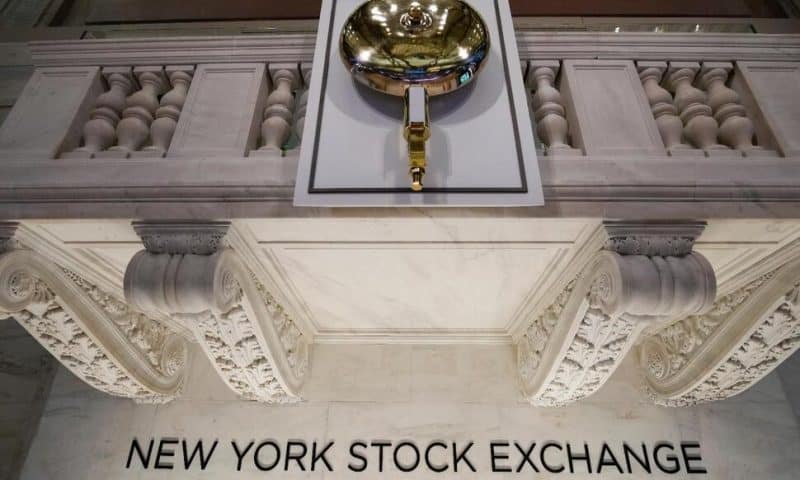Stocks were mixed on Wall Street Monday in their first trading after a report heightened speculation the Federal Reserve may tap the brakes again on financial markets and the economy
NEW YORK — Stocks were mixed Monday in their first trading after a report heightened speculation the Federal Reserve may tap the brakes a little harder on financial markets and the economy.
The S&P 500 rose 4.09 points, or 0.1%, to 4,109.11. It did not trade on Friday, when data showing a resilient U.S. jobs market heightened expectations the Fed would hike interest rates again at its next meeting.
Big Tech stocks fell more than the rest of the market, which helped drag the Nasdaq composite down 3.60, or less than 0.1%, to 12,084.36. It was down as much as 1.4% earlier in the day. The Dow Jones Industrial Average was steadier, and it rose 101.23, or 0.3%, to 33,586.52.
Higher rates tend to hit tech and other high-growth stocks the hardest, and Apple and Microsoft were the two heaviest drags on the S&P 500. Apple fell 1.6%, and Microsoft slipped 0.8.%.
Tesla also dipped 0.3% after paring a sharper, early loss. The company cut prices on its entire U.S. model lineup in an apparent attempt to to entice buyers amid rising interest rates, which make auto loans more expensive.
The Fed has raised interest rates at a furious pace over the last year in hopes of undercutting high inflation. Higher rates can do that, but only by bluntly slowing the entire economy in one fell swoop. That raises the risk of a recession in the future and drags down prices for stocks, bonds and other investments.
Traders are betting on a roughly 70% probability the Fed will raise its key overnight interest rate in May by 0.25 percentage points to a range of 5% to 5.25%, according to data from CME Group. A day before Friday’s jobs report, they saw a roughly coin flip’s chance that the Fed would stand pat at its next meeting.
The Fed has jacked up rates at every one of its meetings over the past year, forcing them up from near zero at the start of 2022.
While the jobs report raised expectations for another rate hike, it also showed a steady-enough labor market to bolster hopes among some investors that the Fed could pull off what’s called a “soft landing” for the economy. That’s where the Fed succeeds in raising rates just enough to stifle inflation but not so much as to create a severe recession.
Besides Friday’s jobs report showing a slowdown in growth for workers’ wages, which could take some pressure off inflation, a report from earlier last week showed employers are advertising fewer job openings.
“This is encouraging because policymakers need to limit labor demand for now so that supply can catch up, and a decline in job openings is the most painless way to achieve this,” David Mericle and other Goldman Sachs economists wrote in a report.
Hopes for a soft landing helped support stocks whose profits tend to be most closely tied with the strength of the economy. Stocks of industrial companies in the S&P 500 rose 0.9%, for example, most among the 11 sectors that make up the index. That included a 3% gain for Caterpillar. Energy companies and raw-material producers also rose.
The overriding bet within the bond market, though, seems to be that the economy will weaken so much that the Federal Reserve will have to cut rates as soon as this summer.
Lower rates can relax the pressure on the economy and financial markets, but it also could give inflation more room to run. The Fed has so far said it sees no rate cuts happening this year.
Another report due on Wednesday could have a bigger impact on expectations for the Fed. That’s when the U.S. government will release its latest monthly update on prices across the economy at the consumer level. Economists expect it to show inflation slowed last month but remains well above the Fed’s target.
Also this week, earnings reporting season will begin for the biggest U.S. companies. Delta Air Lines, JPMorgan Chase and UnitedHealth Group will be among the first S&P 500 companies to tell investors how much profit they made during the first three months of the year.
Expectations are low, and analysts are forecasting the sharpest drop in earnings per share for S&P 500 companies since the pandemic pummeled the economy in the spring of 2020.
In markets abroad, stocks were mixed across Asia.
Japan’s Nikkei 225 added 0.4% after the new governor of Japan’s central bank signaled he plans no drastic changes in its ultra-low interest rate policy.
In Europe, many stock markets were closed.
In the bond market, Treasury yields were relatively stable after rising Friday in an abbreviated trading session following the U.S. jobs report. The 10-year yield, which helps set rates for mortgages and other important loans, ticked up to 3.42% from 3.41% Friday.

